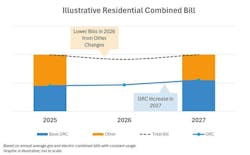PG&E Submits Proposal to Drive California’s Economic Growth and Increase Climate Change Resilience
Pacific Gas and Electric Company (PG&E) has submitted a proposal, its 2027-2030 General Rate Case (GRC), to California regulators, to drive the state’s economic growth and increase climate change resilience.
PG&E and the state's other investor-owned utilities will be required to make multi-year cost proposals every four years. PG&E's application highlighted a strategy to deliver customer bill stability while improving safety.
PG&E is requesting its smallest GRC percentage increase in a decade, partly by reducing costs and passing on savings to customers. Over the past three years, the company has implemented new processes and technologies, reducing operating and capital costs by about $2.5 billion.
If the proposal is approved in full, PG&E expects total residential combined gas and electric bills in 2027 to be flat as compared to 2025 bills. Additionally, if electric demand increases, as predicted by the California Energy Commission, bills are predicted to decrease as the costs of operating the system will be shared by more customers.
PG&E also expects no further electric rate increases in 2025, and projects the residential electric rates and average combined bills to be lower in 2026. Cost recovery currently in rates will expire and be removed from rates to offset proposed increases including the 2027 GRC.
If fully approved, total residential combined-use bills are expected to be flat in 2027 as compared to current bills. Although PG&E's GRC proposal, in isolation, will increase bills by a maximum of 3.6% in 2027, total bills are expected to be flat. Other costs will come out of bills in 2026, including those related to the 2023 GRC, wildfire mitigation and storm recovery.
While PG&E's goal is to stabilize bills through 2030, factors expected to deliver additional customer savings, beyond the GRC proposal, include:
- PG&E's $15 billion Department of Energy loan guarantee to save customers $1 billion over the life of the loan and achieve a better credit rating to lower future borrowing costs, and
- Energy demand growth from electric vehicles and data centers
Bills for individual customers is anticipated to vary based on their location, energy used, rate plan, discount programs and other factors.
Among the ways PG&E's proposal is expected to increase safety and reliability for customers:
- Deliver a more modern grid to meet expected historic growth in electricity demand from new homes, businesses, electric vehicles and AI-focused data centers.This includes preparing the grid to serve 3 million EVs by 2030 and ramping up to 20,000 new customer connections per year by 2030.
- Improve wildfire safety through proven layers of wildfire protection.This includes replacing 760 miles of powerlines with stronger poles and covered powerlines; placing 307 miles of powerlines underground in the highest fire-risk areas in 2027, reducing risk on those lines by 98%; installing an additional 114 weather stations for better forecasting and situational awareness; and improving tree trimming by bundling work to reduce costs and minimize impacts for customers.
- Increase clean energy delivery and system resilience to extreme weather impacts.This includes investing in lower-cost solar and battery energy storage to diversify and complement the grid's existing power plant fleet and protect customers from fuel cost volatility; installing more microgrids in remote areas to reduce wildfire risk and lower costs by removing powerlines and decreasing the need for maintenance; accelerating EV adoption to increase vehicle-to-grid capabilities so EVs can serve as mobile batteries during peak summer energy demand periods; and modernizing existing clean hydroelectric plants to improve safety and reliability, including spillway improvements.
- Strengthen the gas system to keep customers and communities safe and improve air quality. This includes replacing 164 miles of distribution pipeline and upgrading internal pipeline inspections processes to continue safe operations and extend the lifespan of pipelines; responding to more than 600,000 calls to locate and mark lines to reduce the likelihood of third-party pipeline dig-ins; and using advanced mobile leak detection technology to quickly find and fix gas leaks for safety and to reduce methane emissions.
